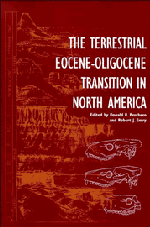Crossref Citations
This Book has been
cited by the following publications. This list is generated based on data provided by Crossref.
Van Valkenburgh, Blaire
1999.
MAJOR PATTERNS IN THE HISTORY OF CARNIVOROUS MAMMALS.
Annual Review of Earth and Planetary Sciences,
Vol. 27,
Issue. 1,
p.
463.
HOOKER, J. J.
2001.
Tarsals of the extinct insectivoran family Nyctitheriidae (Mammalia): evidence for archontan relationships.
Zoological Journal of the Linnean Society,
Vol. 132,
Issue. 4,
p.
501.
Albright, L. Barry
2001.
J. Alan Holman: Fossil Snakes of North America: Origin, Evolution, Distribution, Paleoecology.
Journal of Vertebrate Paleontology,
Vol. 21,
Issue. 1,
p.
201.
Zanazzi, Alessandro
Kohn, Matthew J.
MacFadden, Bruce J.
and
Terry, Dennis O.
2007.
Large temperature drop across the Eocene–Oligocene transition in central North America.
Nature,
Vol. 445,
Issue. 7128,
p.
639.
Métais, Grégoire
Soe, Aung Naing
Marivaux, Laurent
and
Beard, K. Christopher
2007.
Artiodactyls from the Pondaung Formation (Myanmar): new data and reevaluation of the South Asian Faunal Province during the Middle Eocene.
Naturwissenschaften,
Vol. 94,
Issue. 9,
p.
759.
Janis, Christine M.
Gunnell, Gregg F.
and
Uhen, Mark D.
2008.
Evolution of Tertiary Mammals of North America.
p.
737.
Janis, Christine
Hulbert, Richard C.
and
Mihlbachler, Matthew C.
2008.
Evolution of Tertiary Mammals of North America.
p.
645.
Prothero, Donald R.
2009.
Evolutionary Transitions in the Fossil Record of Terrestrial Hoofed Mammals.
Evolution: Education and Outreach,
Vol. 2,
Issue. 2,
p.
289.
Prothero, Donald R.
2011.
Matthewlabis, new name forParalabisLull, 1921, preoccupied.
Journal of Vertebrate Paleontology,
Vol. 31,
Issue. 5,
p.
1168.
Rincon, Aldo F.
Bloch, Jonathan I.
Suarez, Catalina
MacFadden, Bruce J.
and
Jaramillo, Carlos A.
2012.
New floridatragulines (Mammalia, Camelidae) from the early Miocene Las Cascadas Formation, Panama.
Journal of Vertebrate Paleontology,
Vol. 32,
Issue. 2,
p.
456.
Figueirido, Borja
Janis, Christine M.
Pérez-Claros, Juan A.
De Renzi, Miquel
and
Palmqvist, Paul
2012.
Cenozoic climate change influences mammalian evolutionary dynamics.
Proceedings of the National Academy of Sciences,
Vol. 109,
Issue. 3,
p.
722.
Prothero, Donald
2012.
Cenozoic Mammals and Climate Change: The Contrast between Coarse-Scale versus High-Resolution Studies Explained by Species Sorting.
Geosciences,
Vol. 2,
Issue. 2,
p.
25.
Westerhold, Thomas
and
Röhl, Ursula
2013.
Orbital pacing of Eocene climate during the Middle Eocene Climate Optimum and the chron C19r event: Missing link found in the tropical western Atlantic.
Geochemistry, Geophysics, Geosystems,
Vol. 14,
Issue. 11,
p.
4811.
PROTHERO, Donald R.
2014.
Species longevity in North American fossil mammals.
Integrative Zoology,
Vol. 9,
Issue. 4,
p.
383.
Westerhold, T.
Röhl, U.
Pälike, H.
Wilkens, R.
Wilson, P. A.
and
Acton, G.
2014.
Orbitally tuned timescale and astronomical forcing in the middle Eocene to early Oligocene.
Climate of the Past,
Vol. 10,
Issue. 3,
p.
955.
Cadena, Edwin
and
Jaramillo, Carlos
2015.
Early to Middle Miocene Turtles from the Northernmost Tip of South America: Giant Testudinids, Chelids, and Podocnemidids from the Castilletes Formation, Colombia.
Ameghiniana,
Vol. 52,
Issue. 2,
p.
188.
Korth, William W.
Boyd, Clint A.
and
Person, Jeff J.
2019.
Whitneyan (Middle Oligocene) Rodents from Obritsch Ranch (Stark County, North Dakota) and a Review of Whitneyan Rodent Fossil Record.
Annals of Carnegie Museum,
Vol. 85,
Issue. 3,
p.
249.
Adrian, Brent
Holroyd, Patricia A.
Hutchison, J. Howard
and
Townsend, KE Beth
2020.
Additional records and stratigraphic distribution of the middle Eocene carettochelyid turtleAnosteira pulchrafrom the Uinta Formation of Utah, North America.
PeerJ,
Vol. 8,
Issue. ,
p.
e9775.
Prothero, Donald R.
2020.
Encyclopedia of Solid Earth Geophysics.
p.
1.
Stidham, Thomas A.
Townsend, K.E. Beth
and
Holroyd, Patricia A.
2020.
Evidence for Wide Dispersal in a Stem Galliform Clade from a New Small-Sized Middle Eocene Pangalliform (Aves: Paraortygidae) from the Uinta Basin of Utah (USA).
Diversity,
Vol. 12,
Issue. 3,
p.
90.





